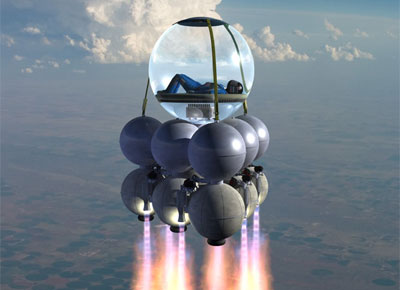So you want to be a rocket pilotby Jeff Foust
|
| “Basically, the rules for piloting are fairly simple,” said Randall Clague of XCOR Aerospace. |
Companies operating these vehicles, though, will probably have higher standards that what’s mandated by the government. “I think, in practice, it’s probably going to require a little bit more than that,” said Erik Anderson, who flies C-130s for the US Air Force. “I don’t think you’re going to be strapping people into an airplane with anybody less than a commercial rating.”
“I dove into this late last year,” said Ian Kluft, who has upgraded his private pilot’s license to a commercial one and is training to become a flight instructor “so I have the hours so that, when there is a line, I want to be in line to fly one of these things.”
The government regulations say very little, though, about what training is needed for someone with a pilot’s license of any kind to be ready to fly a suborbital vehicle. “The biggest problem here is, at least at first, there are hardly any rocketplanes out there,” said Mark Street, an XCOR engineer and a private pilot. “So there are no rocketplanes available for training, and there are certainly no rocketplanes that the owners are going to be renting out or leasing.”
Instead, he said that potential pilots need to find analogous experiences in other aircraft to prepare them for aspects of a suborbital rocket-powered vehicle flight. For example, pilots can prepare for the g-forces and unusual attitudes associated with suborbital rocketplanes by flying aerobatic planes. “It’s a lot of fun on its own, and it’s fairly easy to get into,” he said. Flying a jet trainer like an L-39, he said, can give pilots accustomed to light aircraft experience with faster, heavier vehicles. Flying gliders can give pilots experience with bringing rocketplanes back to unpowered runway landings.
However, there are some aspects of rocket-powered vehicles that cannot be simulated well in other aircraft, including their high thrust-to-weight ratios and supersonic speeds. “About the best I can say there is to find the highest performance aircraft that you can and get some experience in it,” Street advised.
An unglamorous profession?
It’s easy to see how idea of flying a vehicle powered by rocket engines at several times the speed of sound to the edge of space or beyond has a certain cachet to it. Some might imagine that this new profession—rocket pilot—might even have a degree of romance and glamour attached to it, like barnstorming pilots from the early 20th century or the astronauts from the early Space Age. But at least one prominent person in this field has a sharply different assessment of just how interesting this profession will be.
“There’s a glamour to the rocket pilot-type thing that most people are looking at, and I understand that,” John Carmack of Armadillo Aerospace said. “But that’s not what we’re doing with our rocket vehicles and I don’t think that’s where the commercial rocket industry is going to be going.” Later, he added: “Wanting to become a commercial rocket pilot is like wanting to become an elevator operator.”
That assessment is based on his own experience flying Armadillo’s vehicles in the Lunar Lander Challenge and as part of their ongoing test program. Carmack flies the vehicles using a laptop, and for a time even used a Microsoft Sidewinder joystick to control the vehicles. “It’s like a video game,” he said. “I bring it up, I fly it over, I watch pressure curves and various other things, looking for something not behaving right, move it over, and set it down. That’s the extent of the piloting experience.”
That experience for Armadillo’s vertical takeoff, vertical landing vehicles is very different from the “stick-and-rudder” approach to conventional flying, one that Carmack believes isn’t well-suited to spaceflight. “Especially as you start going to greater and greater altitudes, and orbital, I really don’t think you’re going to be stick-and-ruddering airplanes through into orbit and reentering,” he said.
| Carmack: “Wanting to become a commercial rocket pilot is like wanting to become an elevator operator.” |
Carmack believes the flight experience will be so automated that operators will have little to do, hence the comparison to elevator operators. “That’s going to be the level of excitement: punch a button, watch a bunch of graphs to catch anything the computer control or whatever other expert system you have looking at this doesn’t, and you have a couple options: abort early, complete shutdown, and that’s about it,” he said. “There’s just not that much else that goes on.”
“The analogy with the elevator is very, very true,” he continued. “You used to have people in there running the switch, making sure you don’t hit the ground too hard,” but that is all automated now. Early test flights of vehicles will require a greater role for pilots as the vehicle’s flying characteristics are understood, he said, “but once it gets to the point of lots and lots of people flying on these things—elevator.”
There will be opportunities for rocket pilots who want to get involved in testing vehicles, or in high-performance applications like racing, he said. “There’s going to be cool stuff there, but it’s somewhat misleading to talk about it in terms of rocket pilots in a commercial sense.”
That assessment, though, doesn’t appear to deter people like Kluft, who organized the panel at the conference. “I was a little concerned about how well accepted this will be,” he said. However, the panel came together quickly, and at the conference “people were showing me their agendas where they had marked an asterisk on this panel; this is the one they’re coming to. Yeah, I think the idea has been accepted.”
